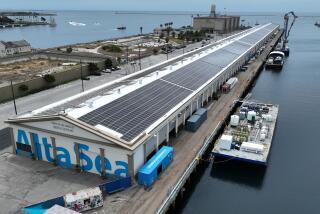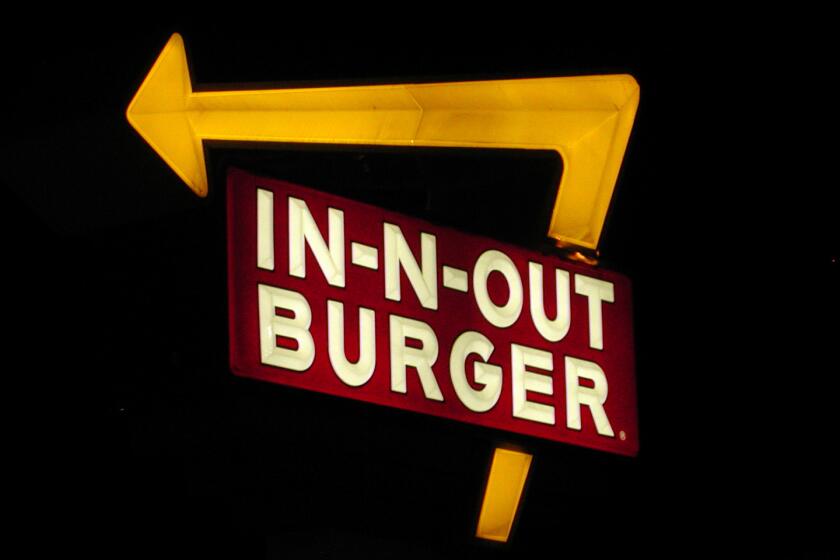For sale: An expanse of aviation history
- Share via
A chunk of Howard Hughes’ Los Angeles is on the block: the cavernous hangar where the aviation mogul built his infamous Spruce Goose aircraft that flew only once -- for about one minute -- in 1947.
It was wartime when Hughes Aircraft Co. got a government contract to build three flying boats intended to transport troops and equipment across oceans. Hughes set out to build a seaplane capable of carrying 750 fully armed soldiers nonstop from Honolulu to Tokyo.
Among his many challenges was the fact that no plane that big had ever been built, and he couldn’t use materials considered crucial to the war effort, such as aluminum, to make it. He decided to use wood and settled on birch, which made the popular nickname “Spruce Goose” irksome to him.
The plane’s real name was Hercules. It sported a wingspan of 320 feet and weighed 200 tons. It was built in a redwood hangar that remains south of Marina del Rey on a wide patch of land where office campuses are being built to complement Playa Vista’s residential neighborhood under construction next door.
The hangar that was built to help win a war is now used mainly for movie and television shoots. Its owner hopes to sell the building to a studio operator who will enlarge its role in the entertainment industry.
“We don’t pretend to know that business,” said John Miller of Tishman Speyer Properties, a New York real estate company that acquired the hangar last year when it bought 64 acres south of Marina del Rey to develop a $1.2-billion office complex.
Miller declined to reveal how much his company hoped to get for the property, but real estate experts familiar with the hangar value it at more than $60 million.
The hangar is longer than two football fields and at 281,000 square feet is one of the largest wooden structures in the world. It is all under one roof looming about seven stories up. It was divided in two the long way so that Hughes’ teams could build the plane’s fuselage in one half and the wings in the other.
The vast expanses have lent themselves to the creation of spectacle-size motion picture sets. Movies filmed there include “Titanic,” “World Trade Center” as well as “Transformers” and its coming sequel. Raleigh Studios manages shooting there on Tishman’s behalf.
The enormous scale of the facility is a testament to the country’s determination to win World War II and Hughes’ vision, ego and nerve. In 1942, months after the U.S. went to war, Hughes and shipbuilder Henry Kaiser got an $18-million government contract to build flying boats, and Hughes set out to bring the world’s largest plane into the fight.
The hangar did not, however, play a part in “The Aviator,” a 2004 movie about Hughes that was filmed in Canada. But it remains one of the most visible pieces of the Hughes legacy. He died in 1976.
“It’s really a unique facility,” said Todd Lindgren of FilmLA Inc., a nonprofit organization that arranges filming throughout the city and county. “It does see a good amount of filming.”
Busy as it is, the building does have some limitations as a soundstage that a new owner might need to address. Among other things, noise travels from one side to the other, so both stages can’t be used at the same time.
“It has sound issues,” said Victor Coleman of Hudson Capital, a Hollywood studio owner familiar with the property. Also, it’s not certified by the county Fire Department as a soundstage, which means each production needs an on-location filming permit.
Bringing it up to standards found at established studios would be costly, Coleman said. “Big capital expenditures will be needed, including probably a parking structure.”
But, Coleman acknowledged, the Westside is a desirable location for filmmakers, and the sheer size of the Spruce Goose hangar makes it competitive. “The demand for that type of facility for a major feature is still pretty high,” even in a tight economy, he said.
The audaciousness of the plan suited Hughes, who was at his swashbuckling peak at the time, said Geoff Schumacher, author of “Howard Hughes: Power, Paranoia and Palace Intrigue.” In the 1930s Hughes set airplane speed records, cavorted with movie stars and built motion picture and aviation empires.
After the U.S. was drawn into World War II, “he tried very hard to become a major defense contractor and help win the war,” Schumacher said.
But Hughes fell out with partner Kaiser, failed to complete the plane in time for the war and faced an angry Senate committee concerned that he had misappropriated funds. He put $7 million of his own money into the Hercules project to keep it going.
On Nov. 2, 1947, Hughes himself was at the controls when the plane was finally placed in Long Beach Harbor for early tests to see if it could taxi smoothly through the water. But to the delight of surprised reporters and onlookers, he lifted the plane about 70 feet off the water and was airborne for about a minute.
“It was crazy,” author Schumacher said in an interview, for the chief executive to play test pilot, but Hughes had been involved in every facet of development and was determined to prove to doubters that the big bird could fly.
But that was it. The Spruce Goose was stored and then displayed in Long Beach before being moved to an Oregon museum in the 1990s. The hangar where it was built has changed little and is eligible for the National Register of Historic Places, said Linda Dishman of the Los Angeles Conservancy.
That place could be hugely productive again if a new owner refitted it, said Miller of owner Tishman. “You could divide one side into three TV soundstages and film movies on the other. You could do multiple shoots at the same time.”
Investors and large film production companies looking for a reliable place to shoot are checking it out, said real estate broker Carl Muhlstein, who represents Tishman. “There is a shortage of soundstages,” he said. “And investors like studios because they have irreplacable tracts of land in dense urban areas.”
--
--
On latimes.com
Historic images
A photo gallery of the seaplane project. latimes.com/hughes
More to Read
Inside the business of entertainment
The Wide Shot brings you news, analysis and insights on everything from streaming wars to production — and what it all means for the future.
You may occasionally receive promotional content from the Los Angeles Times.











